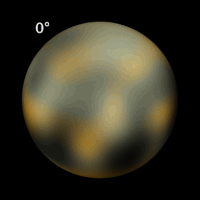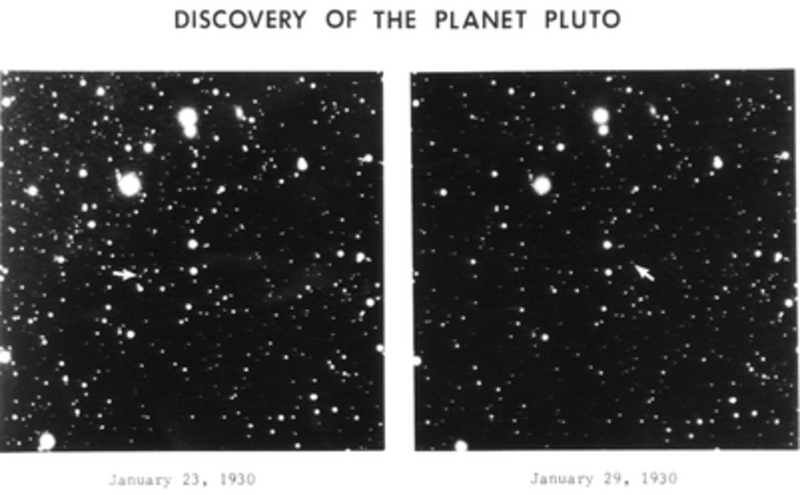
| |
Discovery
| |
|---|---|
| Discovered by | Clyde W. Tombaugh |
| Discovery date | February 18, 1930 |


| Clyde W. Tombaugh alongside is the telescope used. |
 Pluto, formal designation 134340 Pluto, is the second-most-massive known dwarf planet in the Solar System (after Eris) and the tenth-most-massive body observed directly orbiting the Sun. Originally classified as the ninth planet from the Sun, Pluto was recategorized as a dwarf planet and plutoid due to the discovery that it is one of several large bodies within the newly charted Kuiper belt.
Pluto, formal designation 134340 Pluto, is the second-most-massive known dwarf planet in the Solar System (after Eris) and the tenth-most-massive body observed directly orbiting the Sun. Originally classified as the ninth planet from the Sun, Pluto was recategorized as a dwarf planet and plutoid due to the discovery that it is one of several large bodies within the newly charted Kuiper belt. The name Pluto was proposed by Venetia Burney (1918–2009), an eleven-year-old schoolgirl in Oxford, England. Venetia was interested in classical mythology as well as astronomy, and considered the name, a name for the god of the underworld, appropriate for such a presumably dark and cold world. She suggested it in a conversation with her grandfatherFalconer Madan, a former librarian at the University of Oxford's Bodleian Library. Madan passed the name to ProfessorHerbert Hall Turner, who then cabled it to colleagues in the United States.
The name Pluto was proposed by Venetia Burney (1918–2009), an eleven-year-old schoolgirl in Oxford, England. Venetia was interested in classical mythology as well as astronomy, and considered the name, a name for the god of the underworld, appropriate for such a presumably dark and cold world. She suggested it in a conversation with her grandfatherFalconer Madan, a former librarian at the University of Oxford's Bodleian Library. Madan passed the name to ProfessorHerbert Hall Turner, who then cabled it to colleagues in the United States.Space Topics: Compare the Planets
Worlds of the Solar System
Our solar system contains roughly a hundred round worlds in a wide range of sizes from gas giants like Jupiter to small rocky worlds like Mars to iceballs like Enceladus. Take a tour of the sizes of bodies in the solar system.We begin at a very large scale, taking a distant view of the solar system. This largest scale, of 1,000 kilometers (623 miles) pixel, is the only one at which a tiny piece of the Sun can be fit onto the page. The Sun is vastly more enormous than everything else in the solar system put together. The gas giants Jupiterand Saturn and ice giants Uranus and Neptunedominate the rest of the worlds of the solar system. The rest of the planets are just visible at this scale.Earth, Venus, and Mars come in at 13, 12, and 7 pixels across, respectively. But a few of the giant moons are visible: Jupiter's Ganymede and Saturn'sTitan are larger than the planet Mercury, and Jupiter's Callisto is just about as big.The Solar System at a Scale of 1,000 Kilometers Per Pixel
 |
| The Sun - 1,391,000 km diameter |
 |  |  Uranus 51,118 km | Neptune 49,528 km |
| Jupiter 142,984 km | Saturn 120,536 km (main rings 273,550 km) |
| Earth 12,756 km | Venus 12,104 km | Mars 6,794 km | Ganymede 5,262 km | Titan 5,150 km | Mercury 4,879 km | Callisto 4,821 km |
The Solar System at a Scale of 100 Kilometers Per Pixel
Zooming in by a factor of 10 gets us to the scale of the terrestrial planets and the solar system's large moons. The gas and ice giants would be too large to fit on the page at this scale. Earth and Venus are now the standouts, both significantly larger than anything else visible at this scale. Then the smallest planets mix in size with the largest moons: Mars is followed closely in size by Jupiter's Ganymede and Saturn's Titan, both of which are larger than Mercury. Next in size come Jupiter's Callisto and Io, Earth's Moon, Jupiter's Europa, and Neptune's Triton, all of which are larger than Pluto. A jump down in size takes you to the icy moons of the outer solar system: Uranus' Titania, Saturn's Rhea, Uranus' Oberon, Saturn's Iapetus, Pluto's Charon, Uranus' Umbriel and Ariel, and Saturn's Dione andTethys. Finally, just a bit smaller than these, comes the largest of all the asteroids, Ceres. Several trans-Neptunian objects would appear at this scale but are not included because their sizes are uncertain and no images are available. |  |  Mars 6,794 km | Ganymede 5,262 km |  Titan 5,150 km |
| Earth 12,756 km | Venus 12,104 km |
Europa 3,122 km | Triton 2,707 km | Pluto 2,390 km | ||||
| Mercury 4,879 km | Callisto 4,821 km | Io 3,643 km | The Moon 3,476 km |
| Titania 1,578 km | Rhea 1,528 km | Oberon 1,523 km | Iapetus 1,436 km | Charon 1,186 km | Umbriel 1,169 km | Ariel 1,162 km | Dione 1,162 km | Tethys 1,162 km | Ceres 960 km |
The Solar System at a Scale of 10 Kilometers Per Pixel
Zooming in by a factor of 100 from the orginal view takes us to a scale where the worlds of the solar system begin to deviate from spherical shapes, where mountains and ridges clearly spike above their visible disks. At this size, gravity (which tends to flatten mountains over time) is quite weak, and often is not strong enough to overcome the inherent strength of the rock and ice. At this scale, a spherical shape implies that something happened in the little world's geologic history to heat its interior enough to weaken or even melt the rock or ice and allow gravity to have its way.We begin with the tribe of sub-2,000-kilometer outer planet moons mentioned above:Titania, Rhea, Oberon, Iapetus, Charon, Umbriel, Ariel, Dione, and Tethys. Next up is the largest asteroid, Ceres. Following Ceres there is a jump in size down to the next largest asteroids, Pallas and Vesta. Pallas is also the first world in this lineup that has not yet been visited by a spacecraft or observed with a powerful enough telescope to produce an image that resolves features on its disk. Lumpy Vesta is followed by the surprisingly spherical moons Enceladus (Saturn) and Miranda (Uranus). Neptune's Proteus and Saturn's Mimasare the last of the bodies to achieve a basically spherical shape. The rest of the moonlets and asteroids for which there are images are definitely lumpy. Unfortunately, no disk-resolved images are available for many of the rest of these bodies, so their shapes are not well known.
 |  |  |
| Titania 1,578 km | Rhea 1,528 km | Oberon 1,523 km |
    | |||
| Iapetus 1,436 km | Charon 1,186 km | Umbriel 1,169 km | Ariel 1,162 km |
 |  |  | -- Pallas 570 km | Vesta 525 km | Enceladus 512 km |
| Dione 1,162 km | Tethys 1,066 km | Ceres 960 km |
-- Nereid 340 km | Amalthea 262x146 km | -- Juno 240 km | ||||
| Miranda 480 km | Proteus 440 km | Mimas 418 km | Hyperion 370x280 km |
| -- | -- | -- | -- | -- | -- | |||
| Phoebe 230x220 | Eugenia 226 | Kleopatra 217 | Larissa 216x168 | Galatea 204x184 | Janus 194x190 | Sycorax 190 | Despina 180x148 | Puck 162 |
| -- | -- | -- | -- | -- | -- | |||
| Prometheus 148x100 | Epimetheus 138x110 | Portia 136 | Pandora 110x88 | Thalassa 108x100 | Siwa 103 | Caliban 96 | Naiad 96x60 | Juliet 94 |
Images on this page come from a wide variety of sources, including the Hubble Space Telescope (Mars, Ceres, Vesta), NASA GSFC (Earth, from Terra), the Cassini imaging team (Jupiter, Saturn and its moons), Marc Buie, Lowell Observatory (Pluto and Charon, from Earth-based photometry), Mark Robinson (Mercury, from Mariner 10), Ted Stryk(Uranian and Neptunian moons, from Voyager images), Mattias Malmer (Venus, from Mariner 10), A. Tayfun Öner (Triton, from Voyager), Calvin Hamilton (Titan, from Voyager) and Bill Arnett (the Moon, from his own telescope). The rest are from thePlanetary Photojournal at NASA/JPL (Voyager, Galileo, and SOHO images).


